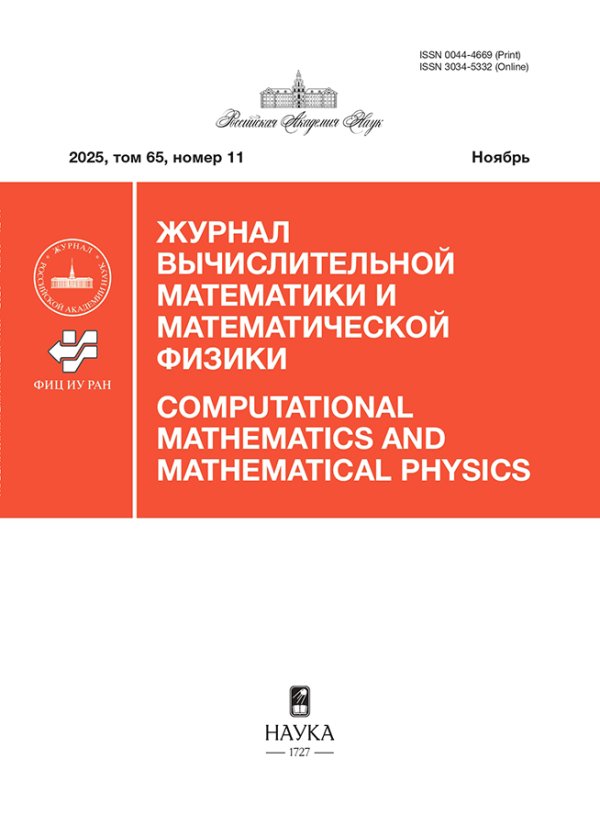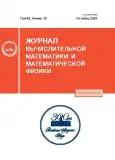Исследование сеточной сходимости сеточно-характеристического метода на химерных сетках в задаче ультразвукового неразрушающего контроля рельсового полотна
- Авторы: Кожемяченко А.А.1,2, Фаворская А.В.1,3
-
Учреждения:
- Московский физико-технический институт
- Научно-исследовательский институт системных исследований РАН
- Научно-исследовательский институт системных исследований Российской академии наук
- Выпуск: Том 63, № 10 (2023)
- Страницы: 1687-1705
- Раздел: МАТЕМАТИЧЕСКАЯ ФИЗИКА
- URL: https://journals.rcsi.science/0044-4669/article/view/140293
- DOI: https://doi.org/10.31857/S0044466923100071
- EDN: https://elibrary.ru/FOEBUS
- ID: 140293
Цитировать
Полный текст
Аннотация
В работе рассматривается пример решения трехмерной прямой задачи ультразвукового контроля в рельсовом полотне, представляемого в виде линейно-упругой среды, с использованием сеточно-характеристического метода на криволинейной структурированной химерной и регулярных структурированных сетках. Между химерной и регулярными сетками используется взаимная интерполяция, учитывающая особенности перехода от криволинейной к регулярной сеткам в трехмерном пространстве. Предложен аналитический алгоритм для построения химерной сетки. Приведены анализ сходимости разработанных численных алгоритмов в зависимости от изменения шага по пространственным направлениям и сравнительный анализ полноволновых полей модуля скорости распространения возмущения от источника. Библ. 43. Фиг. 17.
Об авторах
А. А. Кожемяченко
Московский физико-технический институт; Научно-исследовательский институт системных исследований РАН
Email: anton-kozhemyachenko@yandex.ru
Россия, 141701, М.о., Долгопрудный, Институтский пер., 9; Россия, 117218, Москва, Нахимовский пр-т., 36, к. 1
А. В. Фаворская
Московский физико-технический институт; Научно-исследовательский институт системных исследований Российской академии наук
Автор, ответственный за переписку.
Email: favorskaya@phystech.edu
Россия, 141701, М.о., Долгопрудный, Институтский пер., 9; Россия, Москва
Список литературы
- Rossini N.S., Dassisti M., Benyounis K.Y., Olabi A.G. Methods of measuring residual stresses in components // Materials & Design. 2012. V. 35. P. 572588.
- Hwang Y.I., Kim Y.I., Seo D.C., Seo M.K., Lee W.S., Kwon S., Kim K.B. Experimental Consideration of Conditions for Measuring Residual Stresses of Rails Using Magnetic Barkhausen Noise Method // Materials. 2021. V. 14. № 18. P. 5374.
- Palkowski H., Brück S., Pirling T., Carradò A. Investigation on the Residual Stress State of Drawn Tubes by Numerical Simulation and Neutron Diffraction Analysis // Materials. 2013. V. 6. № 11. P. 51185130.
- Kelleher J., Prime M.B., Buttle D., Mummery P., Webster P.J., Shackleton J., Withers P.J. // The Measurement of Residual Stress in Railway Rails by Diffraction and Other Methods // Journal of Neutron Research. 2003. V.11. № 4. P. 187–193.
- Huang H., Zhang K., Wu M., Li H., Wang M.J., Zhang S.M., Chen J.H., Wen M. Comparison between axial residual stresses measured by Raman spectroscopy and X-ray diffraction in SiC fiber reinforced titanium matrix composite // Acta Physica Sinica. 2018. V. 67. № 19. P. 267276
- Li Z., He J., Teng J., Wang Y. Internal Stress Monitoring of In-Service Structural Steel Members with Ultrasonic Method // Materials. 2016. V. 9. № 4. P. 223.
- Jia D.W., Bourse G., Chaki S., Lacrampe M.F., Robin C., Demouveau H. Investigation of stress and temperature effect on the longitudinal ultrasonic waves in polymers // Research in Nondestructive Evaluation. 2014. V. 25. № 1. P. 2029.
- Javadi Y., Azarib K., Ghalehbandi S.M., Roy M.J. Comparison between using longitudinal and shear waves in ultrasonic stress measurement to investigate the effect of post-weld heat-treatment on welding residual stresses // Research in Nondestructive Evaluation. 2017. V. 28 № 2. P. 101122.
- Hwang Y.I., Kim G., Kim Y.I., Park J.H., Choi M.Y., Kim K.B. Experimental Measurement of Residual Stress Distribution in Rail Specimens Using Ultrasonic LCR Waves // Applied Sciences. 2021. V. 11. № 19. P. 9306.
- Guo J., Fu H., Pan B., Kang R. Recent progress of residual stress measurement methods: A review // Chinese Journal of Aeronautics. 2021. V. 34. № 2. P. 5478.
- Alahakoon S., Sun Y.Q., Spiryagin M., Cole C. Rail flaw detection technologies for safer, reliable transportation: a review // J. of Dynamic Systems, Measurement, and Control. 2018. V. 140. № 2. P. 020801.
- Gao X., Liu Y., Li J., Gao X. Automatic recognition and positioning of wheel defects in ultrasonic B-scan image using artificial neural network and image processing // J. of Testing and Evaluation. 2019. V. 48. № 1. P. 20180545.
- Yu H., Li Q., Tan Y., Gan J., Wang J., Geng Y., Jia L. A Coarse-to-Fine Model for Rail Surface Defect Detection // IEEE Transactions on Instrumentation and Measurement. 2019. V. 68. № 3. P. 656666.
- Wu F.P., Li Q., Li S., Wu T. Train rail defect classification detection and its parameters learning method // Measurement. 2020. V. 151. № 2. P. 107246.
- Tang Z., Liu F.J., Guo S.H., Chang J., Zhang J.J. Evaluation of coupled finite element/meshfree method for a robust full-scale crashworthiness simulation of railway vehicles // Advances in Mechanical Engng. 2016. V. 8. № 4. P. 1687814016642954.
- Adak D., Pramod L.N.A., Ooi E.T., Natarajan S. A combined virtual element method and the scaled boundary finite element method for linear elastic fracture mechanics // Engng Analysis with Boundary Elements. 2020. V. 113. P. 916.
- Teng Z.H., Sun F., Wu S.C., Zhang Z.B., Chen T., Liao D.M. An adaptively refined XFEM with virtual node polygonal elements for dynamic crack problems // Comput. Mechanics. 2018. V. 62. № 5. P. 10871106.
- Wu S.C., Zhang S.Q., Xu Z.W. Thermal crack growth-based fatigue life prediction due to braking for a high-speed railway brake disc // Internat. Journal of Fatigue. 2016. V. 87. P. 359369 .
- Jiang S., Gu Y., Fan C., Qu W. Fracture mechanics analysis of bimaterial interface cracks using the generalized finite difference method // Theoretical and Applied Fracture Mechanics. 2021. V. 113. P. 102942.
- Nejad R.M., Liu Z., Ma W., Berto F. Reliability analysis of fatigue crack growth for rail steel under variable amplitude service loading conditions and wear // Internat. Journal of Fatigue. 2021. V. 152. P. 106450.
- Li S., Wu Y. Energy-preserving mixed finite element methods for the elastic wave equation // Appl. Math. and Comput.2022. V. 422. № 15. P. 126963.
- Cao J., Chen J.B. A parameter-modified method for implementing surface topography in elastic-wave finite-difference modeling // Geophysics. 2018. V. 83. № 6. P. 313–332.
- Duru K., Rannabauer L., Gabriel A.A., Igel H. A new discontinuous Galerkin method for elastic waves with physically motivated numerical fluxes // J. of Scientific Computing. 2021. V. 88. № 3. P. 1–32.
- Huang J., Hu T., Li Y., Song J., Liang S. Numerical dispersion and dissipation of the triangle-based discontinuous Galerkin method for acoustic and elastic velocity-stress equations // Computers & Geosciences. 2022. V. 159. № 1. P. 104979.
- Ladonkina M.E., Neklyudova O.A., Ostapenko V.V., Tishkin V.F. On the Accuracy of the Discontinuous Galerkin Method in Calculation of Shock Waves // Comput. Math. and Math. Phys. 2018. V. 58. № 8. P. 13441353.
- Sepehry N., Ehsani M., Asadi S., Shamshirsaz M., Nejad F.B. Fourier spectral element for simulation of vibro-acoustic modulation caused by contact nonlinearity in the beam // Thin-Walled Structures. 2022. V. 174. P. 109112.
- Trinh P.T., Brossier R., Métivier L., Tavard L., Virieux J. Efficient time-domain 3D elastic and viscoelastic full-waveform inversion using a spectral-element method on flexible Cartesian-based mesh. // Geophysics. 2019. V. 84. № 1. P. 61–83.
- Godunov S.K., Denisenko V.V., Klzuchinskii D.V., Fortova S.V., Shepelev V.V. Study of Entropy properties of Linearized Version of Godunov’s Method // Comput. Math. and Math. Phys. 2020. V. 60. № 4. P. 628640.
- Kovyrkina O., Ostapenko V.V. Monotonicity of the CABARET Scheme Approximating a Hyperbolic System of Conservation Laws // Comput. Math. and Math. Phys. 2018. V. 58. № 9. P. 14351450.
- Chukhno V.I., Usov E. CABARET Scheme as Applied to Numerical Approximation of Two-Fluid Flow Equations // Comput. Math. and Math. Phys. 2018. V. 58. № 9. P. 14511461.
- Gordon R., Turkel E., Gordon D. A compact three-dimensional fourth-order scheme for elasticity using the first-order formulation // Internat. Journal for Numerical Methods in Engng. V. 122. № 21. P. 6341–6360.
- Lu Z., Ma Y., Wang S., Zhang H., Guo J., Wan Y. Numerical simulation of seismic wave triggered by low-frequency sound source with 3D staggered-grid difference method in shallow water // Arabian Journal of Geosciences. 2021. V. 14. № 6. P. 1–8.
- Favorskaya A.V., Zhdanov M.S., Khokhlov N.I., Petrov I.B. Modelling the wave phenomena in acoustic and elastic media with sharp variations of physical properties using the grid-characteristic method // Geophysical Prospecting. 2018. V. 66. № 8. P. 1485–1502.
- Khokhlov N., Favorskaya A., Stetsyuk V., Mitskovets I. Grid-characteristic method using Chimera meshes for simulation of elastic waves scattering on geological fractured zones // J. of Comput. Phys. 2021. V. 446. № 1. P. 110637.
- Kozhemyachenko A.A., Petrov I.B., Favorskaya A.V., Khokhlov N.I. Boundary conditions for modeling the impact of wheels on railway track // Comput. Math. and Math. Phys. 2020. V. 60. № 9. P. 1539–1554.
- Steger J.L. A Chimera grid scheme: advances in grid generation. American Society of Mechanical Engineers // Fluids Engng Division. 1983. V. 5. P. 55–70.
- Chesshire G., Henshaw W.D. Composite overlapping meshes for the solution of partial differential equations // J. of Comput. Phys. 1990. V.90. № 1. P. 1–64.
- Henshaw W.D., Schwendeman D.W. Parallel computation of three-dimensional flows using overlapping grids with adaptive mesh refinement // J. of Comput. Phys. 2008. V. 227. № 16. P. 7469–7502.
- Chang X.H., Ma R., Wang N.H., Zhao Z., Zhang L.P. A Parallel Implicit Hole-cutting Method Based on Background Mesh for Unstructured Chimera Grid // Computers & Fluids. 2020. V. 198. P. 104403.
- Favorskaya A.V., Khokhlov N.I., Petrov I.B. Grid-Characteristic Method on Joint Structured Regular and Curved Grids for Modeling Coupled Elastic and Acoustic Wave Phenomena in Objects of Complex Shape // Lobachevskii Journal of Mathematics. 2020. V. 41. № 4. P. 512–525.
- Favorskaya A., Khokhlov N. Accounting for curved boundaries in rocks by using curvilinear and Chimera grids // Procedia Computer Science. 2021. V. 192. P. 3787–3794.
- Favorskaya A.V. Simulation of the human head ultrasound study by grid-characteristic method on analytically generated curved meshes // Smart Innovation, Systems and Technologies. 2021. V. 214. P. 249–263.
- Favorskaya A., Khokhlov N., Sagan V., Podlesnykh D. Parallel computations by the grid-characteristic method on Chimera computational grids in 3D problems of railway non-destructive testing // Lecture Notes in Computer Science. 2022. V. 13708. P. 199–213.
Дополнительные файлы





























